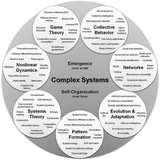⚡️ Modern physics provides a precise language to capture the way things #scale: the so-called #renormalization_group. This mathematical formalism allows us to go systematically from the small to the large. The essential step is taking averages. For example, instead of looking at the behavior of individual atoms that make up matter, we can take little cubes, say 10 atoms wide on each side, and take these cubes as our new building blocks. One can then repeat this averaging procedure.
#Renormalization theory describes in detail how the properties of a physical system change if one increases the length scale on which the observations are made. A famous example is the electric charge of particles that can increase or decrease depending on quantum interactions. A sociological example is understanding the behavior of groups of various sizes starting from individual behavior. Is there wisdom in crowds, or do the masses behave less responsibly?
Most interesting are the two endpoints of the renormalization process: the infinite large and infinite small. Here things will typically simplify because either all details are washed away, or the environment disappears. Both the largest and the smallest structures of the universe are astonishingly #simple. It is here that we find the two “standard models,” of #particle_physics and #cosmology.
🔗 https://www.quantamagazine.org/to-solve-the-biggest-mystery-in-physics-join-two-kinds-of-law-20170907/
#Renormalization theory describes in detail how the properties of a physical system change if one increases the length scale on which the observations are made. A famous example is the electric charge of particles that can increase or decrease depending on quantum interactions. A sociological example is understanding the behavior of groups of various sizes starting from individual behavior. Is there wisdom in crowds, or do the masses behave less responsibly?
Most interesting are the two endpoints of the renormalization process: the infinite large and infinite small. Here things will typically simplify because either all details are washed away, or the environment disappears. Both the largest and the smallest structures of the universe are astonishingly #simple. It is here that we find the two “standard models,” of #particle_physics and #cosmology.
🔗 https://www.quantamagazine.org/to-solve-the-biggest-mystery-in-physics-join-two-kinds-of-law-20170907/
Quanta Magazine
To Solve the Biggest Mystery in Physics, Join Two Kinds of Law
Reductionism breaks the world into elementary building blocks. Emergence finds the simple laws that arise out of complexity. These two complementary ways of
Complex Systems Studies
Quantum Field Theory and Condensed Matter: An Introduction by Ramamurti Shankar (Cambridge Monographs on Mathematical Physics) 1st Edition
Providing a broad review of many techniques and their application to condensed matter systems, this book begins with a review of #thermodynamics and #statistical_mechanics, before moving onto real and imaginary time path integrals and the link between Euclidean quantum mechanics and statistical mechanics. A detailed study of the #Ising, #gauge-Ising and #XY models is included. The #renormalization group is developed and applied to #critical_phenomena, #Fermi_liquid theory and the renormalization of field theories. Next, the book explores bosonization and its applications to one-dimensional fermionic systems and the correlation functions of homogeneous and random-bond Ising models. It concludes with Bohm-Pines and Chern-Simons theories applied to the quantum Hall effect. Introducing the reader to a variety of techniques, it opens up vast areas of condensed matter theory for both graduate students and researchers in theoretical, statistical and condensed matter physics.
